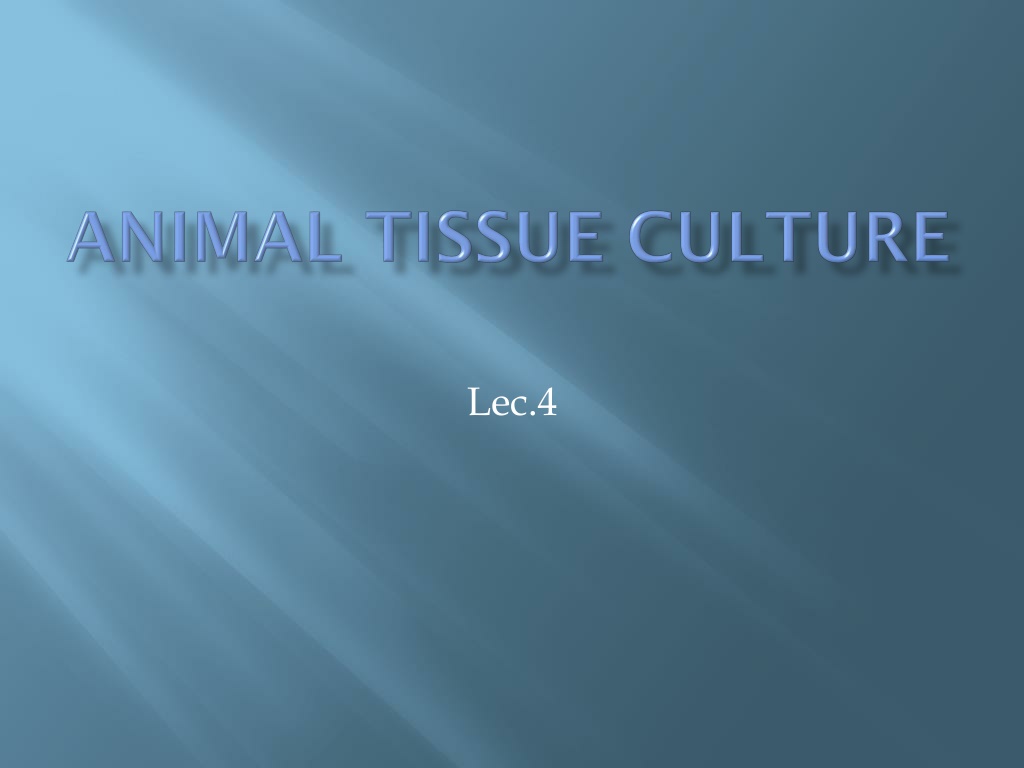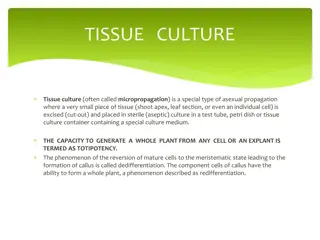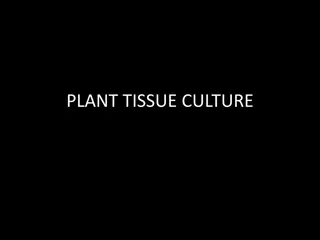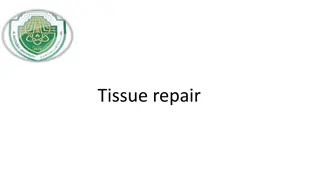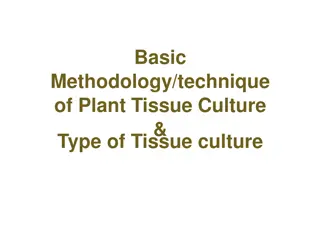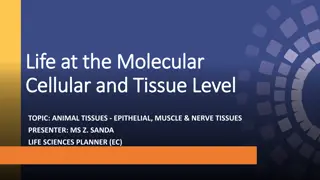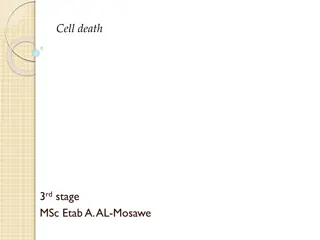Understanding Animal Tissue Culture and Cell Line Production
Animal tissue culture involves growing tissues separate from the animal in a laboratory setting. To achieve exponential cell growth, cells are converted into immortal cell lines. The production of a cell line involves steps like breaking cell adhesion, incubation, and transferring cells to fresh medium. The growth of animal cells is limited to about 50 divisions due to various factors. Culture media play a crucial role in providing the necessary environment for cell growth, with serum being a widely used medium for animal cell culture.
Download Presentation

Please find below an Image/Link to download the presentation.
The content on the website is provided AS IS for your information and personal use only. It may not be sold, licensed, or shared on other websites without obtaining consent from the author. Download presentation by click this link. If you encounter any issues during the download, it is possible that the publisher has removed the file from their server.
E N D
Presentation Transcript
Animal tissue culture: is the growth of tissues separate from the animal in vitro(in the laboratory culture media). Cell line Every cell present in the human body is not capable of growing in laboratory, only a few types of cells can grow in vitro but they are neither suitable for industrial use nor for scientific purpose, why? Because many cells die during the course of time releasing toxic substances which inhibit the activity of other live cells. In order to avoid this problem and to achieve an exponential cell growth, the cells are converted into immortal cells called "cell line".
Procedure for production of a cell line: 1- A piece of tissue is removed from an organism. 2- Adhesion between cells is broken with enzymes like trypsin or collagenase. 3- The cells are transferred to a plastic dish or bottle which contains culture medium. 4- The cells are incubated at 37 C in 5-10% CO2and 90-95% O2. 5- The cells grow, divide and cover the surface of the container, this culture is referred to as primary cell culture, all cells will stop dividing due to contact inhibition.
6- The cells are transferred to a fresh medium and will again start growing. This type of repetitive culturing of the cells is limited, why? Because the growth of animal cells stops after about 50 divisions, either due to lack of proper culture media or built-in-senescence mechanism. 7- Some cells continue to grow after numerous transformations, these are termed as diploid cell strains, also these cells lose the ability to grow after sometimes. 8- Few cells among diploid cell strains will survive; these are termed as heteroploid cells, because they undergo many chromosomal rearrangements and deletions. These cells will grow indefinitely as long as the medium is replaced, becoming effectively immortal. These survivors are known as cell line.
Culture medium: It is the environment provided for the growth of the cells in laboratory, similar to those conditions that the cells have been exposed to in vivo. Culture media consist of: Physical media: a support or matrix Chemical media: appropriate nutrients, hormones and stromal factors Serum is the most economical, easily available and most widely used culture medium for animal cell culture; fetal calf serum is the preferred one. The major functions of serum as a culture medium are: to provide nutrients, hormones, growth factors, attachment and spreading factors, binding proteins, vitamins, minerals, lipids, protease inhibitors and pH buffer.
Disadvantages of serum: Virus, fungi and bacteria may contaminate the serum easily Some enzymes presents in serum can convert the cell secretions into toxic compounds Now there are three types of artificial culture media: Serum free culture medium Protein- free culture medium Chemically defined media Eagles minimal essential medium(EMEM), Dulbeccos modified enriched medium (DMEM) and Rosswell park memorial institude (RPMI) are examples on artificial culture media.
Types of cell cultures: A- Primary cell culture The maintenance of growth of cells separated from the parental tissue in culture medium using suitable glass or plastic containers is called Primary Cell Culture. There are two types of it: 1- Monolayer cultures or Adherent cells; Cells shown to require attachment for growth. They are usually derived from tissues of organs such as kidney. 2- Suspension Culture; Cells which do not require attachment for growth. They are derived from cells of the blood system.
Advantages in propagation of cells by suspension culture method: The process of propagation is much faster. The frequent replacement of the medium is not required. Have a short lag period. Treatment with trypsin is not required. A homogenous suspension of cells is obtained. The maintenance of them is easy and bulk production of the cells is easily achieved. Scale-up is also very suitable.
B- Secondary cell cultures or cell line When a primary culture is sub-cultured, it becomes known as secondary culture or cell line. Subculture (or passage);is the transfer of cells from one culture vessel to another culture vessel. There are two types of Cell Line or Cell Strain:
Finite cell Lines Continuous Cell Lines Have a limited life span Have Exhibit heterogeneicity unlimited life span, They form Exhibit contact inhibition The growth rate is slow grow in monolayer They grow in monolayer or suspension form Absence of contact inhibition the property of The growth rate is rapid Doubling time is around 24- 96 hours Doubling time is 12-24 hours
Scale up of animal cell culture Scaling up is the modifying a laboratory procedure, so that it can be used on an industrial scale. For scale-up of animal cell culture process: 1- Roller Bottles with Micro Carrier Beads are used for adherent cells. The Roller bottles provide total curved surface area of the micro carrier beads for growth. The continuous rotation of the bottles helps to provide medium to the entire cell monolayer in culture.
This system has the advantages over the static monolayer culture: -It provides increase in the surface area -Provides constant gentle agitation of the medium -Provides increased ratio of surface area of medium to its volume
Micro Carrier Beads Micro carrier beads are small spherical particles with diameter 90-300 Mm Made up of dextran or glass. Increase the number of adherent cells per flask. Come in a range of densities and sizes. The cells grow at a very high density which rapidly uses the medium. At the recommended concentration when the microcarriers are suspended they provide 0.24 m2 area for every 100 ml of culture flask.
2- Spinner flasks are used for suspension cultures. The spinner flask consists of flat surface glass flask is fitted with a Teflon paddle that continuously turns and agitates the medium. This stirring of the medium improves gas exchange in the cells in culture. The spinner flask used at commercial scale consists of one or more side arms for taking out samples.
Applications of animal cell culture: They are used as substitute hosts to study the pattern of viral infection. They are used in the manufacture of vaccines, antibodies, hormones, interferon, vitamins, steroids, pharmaceutical drugs etc. They are good tools for testing the potency of drugs. They are served as models to study the metabolism of various substances. They are used in study of the effects of toxins and contaminants. Cancer research, which requires the study of uncontrolled cell division in cultures. Used in Cell fusion techniques.
